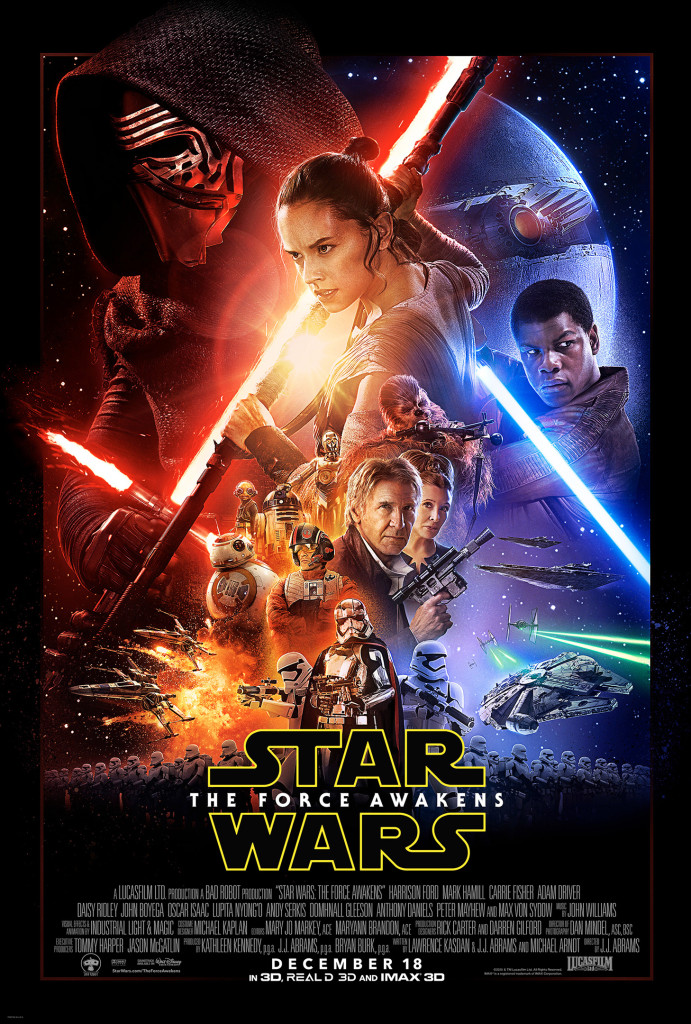The Star Wars franchise has brought in over $32 billion in revenue over the past 38 years, and that’s not even counting the opening weekend of The Force Awakens. The majority of that money is made not through box-office sales, but through merchandise, books, and collectibles. Case in point: I haven’t seen The Force Awakens yet (I know!) but in the past month I’ve purchased more than ten Star Wars products (Christmas shopping for nerdy dads was made easy this year.)
Star Wars creator George Lucas anticipated back in the 1970s that the franchise’s biggest money-maker would be the merchandise. This prediction led him to take a $350,000 pay cut when making the first film, in exchange for the ability to keep merchandising rights. Now, Lucas is worth over $5 billion.
When Disney purchased Lucasfilm, they created a strategic plan to make money off Star Wars for years to come. They’ll be creating more films, expanding the already expanded Star Wars universe, and forming deals with other brands to sell Star Wars licensed products. One of the Star Wars purchases I made last week? A Star Wars t-shirt from my college bookstore, bearing the name of my school and Darth Vader’s mask. Disney is making partnerships anywhere and everywhere, from makeup companies to supermarket oranges. Over the next twelve months, Star Wars is expected to generate $5 billion dollars in merchandise alone.
To see the real success of the Star Wars franchise, you simply have to follow the money. But it’s sort of a case of chicken and egg: are the products marketing the movies, or are the movies marketing the products? These movies are box-office hits that revolutionized science fiction, so it may be a bit cynical to call them advertisements … but they are bringing in a ridiculous amount of money from product sales, just as advertisements are meant to do. In a way, you could view the Star Wars films as content marketing, advertising all of this profitable merchandise.
Viewing Star Wars Through A Content Marketing Lens
As this great article points out, Star Wars actually presents us with an example of content marketing in a fictional universe. Many of the qualities that make the Stars Wars films successful are the same things that bring success in content marketing.
- KISS: Keep it simple, sith lord —
Star Wars offer pretty simplistic story lines. We know who’s the good guy and who’s on the dark side. The binary between good and bad is even color-coded by light sabers.
This is key in content marketing too: you want to use simple, relatable ideas. If your company restores hardwood floors, you don’t want to advertise to customers by explaining the detailed, scientific process your workers use to renovate old wood better than anyone else. Instead, it’d be a lot more relatable to discuss the many benefits to new floors, or maybe publish a blog post about furniture that goes well with hardwood floors and include a Call-To-Action about your services. The point is, people are more likely to follow and support your brand is they can easily understand what you’re trying to say.
- Use consistency, you must —
The Star Wars films have some of the best world-building in any franchise, ever. These sci-fi classics use their own set of rules, physics, technology, and history, but all of these elements remain consistent throughout the films. Even the aesthetics of the films, including the newest movie, look similar.
Consistency is a good idea in content marketing as well. You want to develop a clear, identifiable voice across branding platforms. Your logos should be similar on Twitter, Facebook, and your website. Just as Star Wars needs to establish its world, you need to flesh out your brand’s ideals, policies, and more. People are able to quickly identify the difference between Star Wars and Star Trek, because both have very consistent worlds. Your brand too should be able to stand out from other similar companies.
Star Wars doesn’t just borrow elements from content marketing and act as content marketing itself, but also utilizes content marketing to keep fans interested in between film releases.
The Star Wars Expanded Universe
The Star Wars Expanded Universe is a type of compound content marketing.
The universe consists of the many additional films, video games, comic books, and novels related to Star Wars. These products promote the consumption of the Star Wars films, and the films promote the expanded universe products as well.
You might think your company isn’t creative enough to have a whole expanded universe, but you can use this idea of pushing lots of different types of content. Consider a company like Pillsbury. They use traditional marketing tactics like television ads and grocery store coupons, but they also post recipes on sites like Twitter and Pinterest. It sounds strange comparison, but you could think of the Pillsbury crescent rolls or biscuits as a Star Wars film (the product), and these recipes as the Star Wars Expanded Universe (the compounding ways to market the product). The recipes encourage purchasing Pillsbury products, but purchases the products encourages looking for the recipes. You can find more examples of compound content marketing (and learn about how Star Wars uses it) here.
So, I still haven’t seen The Force Awakens (I’m seeing it next week, don’t worry!), but I’ve already bought a bunch of related products. That’s because the Star Wars films are more than just great movies: they make up a great franchise with lots of carefully calculated marketing decisions behind it. The money behind Star Wars is all from merchandise sales, so it’s pretty lucky that George Lucas took that pay cut in exchange for merchandise rights. But to quote Obi-Wan Kenobi, “In my experience there is no such thing as luck.” – It’s not lucky that Star Wars merchandise took off, it’s the result of content marketing.
Interested in expanding your content marketing universe? Try our free trial…and may the force be with you.
